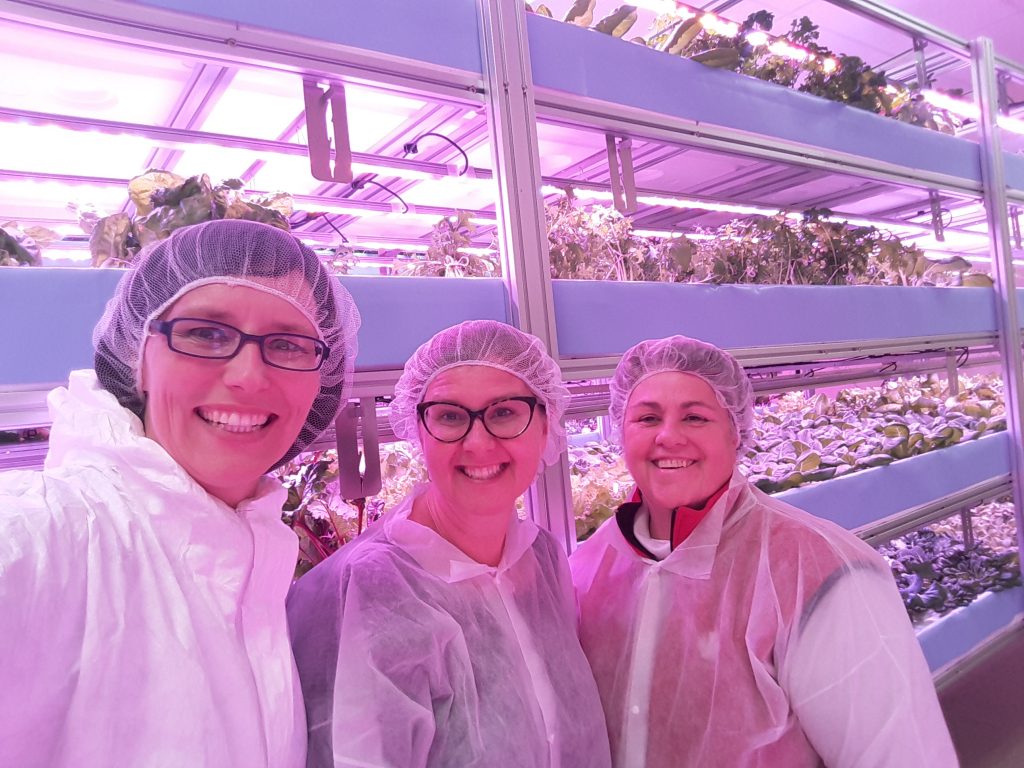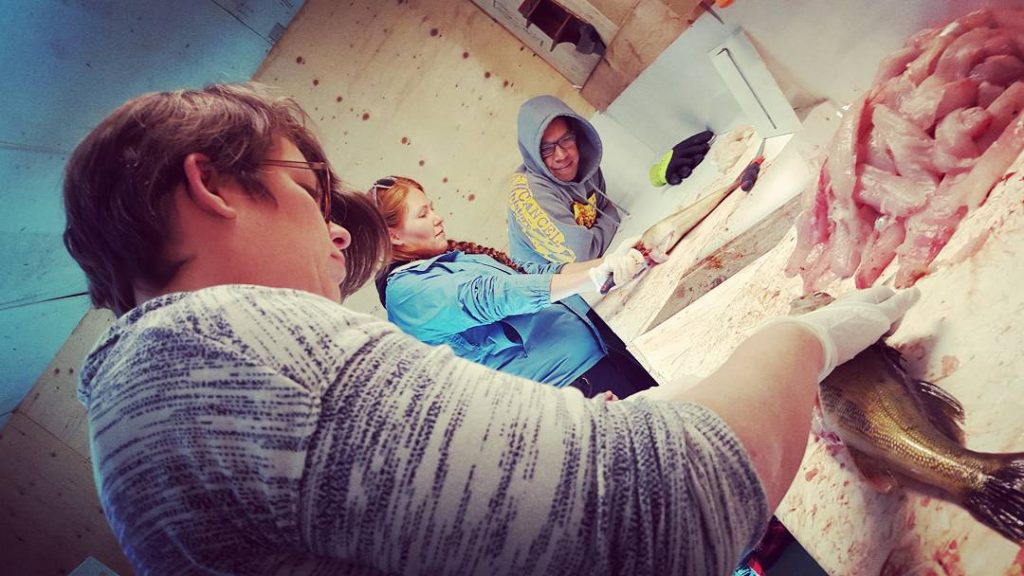By: Becky Cook, Program Associate, Northern Manitoba Food, Culture, and Community Collaborative

Two weeks into my new role as Program Associate with Tides Canada working on the Northern Manitoba Food, Culture, and Community Collaborative (NMFCCC), I had the opportunity to go on the 2016 NMFCCC Learning Trip. The Collaborative’s fourth learning trip took us to Opaskwayak Cree Nation (OCN) and Sherridon for one week. The trip provides the Collaborative’s funders with an opportunity to get to know the community partners, learn about life in northern communities, and understand some of the challenges the people on the ground face. As I am new to the Collaborative, this was my first learning trip experience. It was a fun way to learn more about the Collaborative’s values and meet the representatives from a few of the different funders as well as the community partners.
The trip was a great experience for me and I would like to thank all of the community members from OCN and Sherridon that welcomed us into their communities, shared their experiences with us, and kept us busy for the week. It was great to meet all of you (some again) and learn more about the work you are doing to build healthier communities. I really enjoyed the time we spent on the land in OCN and getting our hands dirty in Sherridon filleting fish and slaughtering chickens.
Opaskwayak Cree Nation
I grew up in Misipawistik Cree Nation in northern Manitoba just downstream from OCN, so I had been there a few times before. When we arrived on Monday evening we were welcomed by the garden group, community elders, and some of the newly elected Councillors, Chief Christian Sinclair, and Vice Chief Jennifer Flett at the Kikiwak Hotel. We went through introductions and learned about the work the garden group has done to make the garden a welcoming place for all members of the community. I really liked hearing about their system of having lead gardeners for the different plots—it spreads the workload out and helps to get more people involved.
On Tuesday, we got out on the land and visited some of the areas around the community. We had a slightly wet lunch at Moose Park before heading off to Pike Lake for the afternoon. Our hosts brought out the voyaging canoes and bows and arrows so we could test out our skills. After the skills competition, we sat around the fire and learned more about the garden group’s plans for the future. Now that the gardens are well established, the group was not sure if they would apply for another grant from the NMFCCC. They made it clear that even if they did not apply for another grant, they still want us to visit. A sentiment that I believe arises from the Collaborative’s values, which were the subject of ongoing discussions during our trip.

The Collaborative values reciprocity, shared learning, working collaboratively, and building relationships in a slow and committed way. On our trip, we had deep discussions about relationships and breaking down the transactional and sometimes dysfunctional relationships many funders have with the programs and people they support. Some on the trip expressed concerns about creating dependencies and defining end points for funding. While these are valid concerns, they are concerns relevant to the traditional transactional funding relationships. Within the Collaborative, the goal is to build relationships with the communities we support. A lot of time and energy is spent on getting to know each other, sharing stories, and learning from each other—all with the goal of empowering community members to “be the change they want to see” in their communities. Talking about end points for the community-Collaborative relationship can be detrimental to the relationship, and could undermine the trust between communities and the Collaborative.
As indicated by the members of the OCN Garden Group, the relationship should continue past the point when a group decides they do not need ongoing monetary support. The Collaborative’s role in the ongoing relationship can be to provide non-monetary support through facilitating peer-to-peer learning exchanges and other events to promote networking, problem-solving, friendship, and story sharing.

While in OCN we also had the opportunity to visit the Plant Factory—another initiative that helps address the availability of fresh vegetables in the north. The Plant Factory uses technology developed in South Korea and brought to OCN through a partnership between OCN Cree Nation and South Korean businessmen. The highly technical operation uses specialized LED lights and nutrient supplements to grow vegetables inside on vertically stacked shelves. It was a stark contrast to the work that the garden group is doing, and it will be interesting to see how the two projects can work in tandem to address health problems brought about by lack of healthy foods.

The highlight of our visit to OCN by far was the dinner we had on Tuesday evening at the garden. The garden group has done a lot of work at the site and it was a truly beautiful setting to get together and share food. The newest project, the summer kitchen, was put to good use and I can’t wait to go back and try out the clay oven when it is finished. Carrots and beets from the garden accompanied the roast bison for our main course, followed by delicious fresh rhubarb and blueberry pies for dessert. Councillor Omar Constant got us all laughing with his storytelling and moose calling contest. Everyone had the chance to show off their pipes and although the locals put up some stiff competition, three of the visitors from our group placed, winning fresh pumpkin and squash from the garden.
Sherridon
On Wednesday, we travelled from OCN to Sherridon and got a bit of time to explore before getting down to business. We stayed at the Kenanow Lodge Hotel on the shores of Camp Lake, which had tailings dumped in it when the Sherritt-Gordon Mine was operating from 1931 to 1951. The lake has since had extremely low pH and all the people in the town know not to swim or even touch the water in the lake because it is so acidic. The view of the tailings pile in the lake from the hotel was blocked, but we could see that all of the driftwood in the lake and the rocks along the shoreline were covered with a layer of rust or oxidized iron, a common by-product of acid mine drainage.

We were joined by the community partners for supper at the lodge, where we had an awesome chocolate cake to celebrate my two-week anniversary with the Collaborative. After supper, we talked about the National Orphaned and Abandoned Mines Initiative (NOAMI) and the work the Manitoba Mines Branch is doing to clean up Camp Lake under the Mine Site Rehabilitation program. The stories from the community did not live up to the optimism presented on the Manitoba Mines Branch website. We heard about unsuccessful attempts to neutralize the lake with lime which ended up blowing around the community and shutting down the school for several weeks. The community members expressed their concerns about the potential adverse health effects for themselves and their children as a result of breathing in the lime dust. The worst part was that after the liming, the lake’s pH dropped down to around 2 to 3 again after only a short period of neutralization. The community members are now fighting to keep the waters from Camp Lake from being released into Kississing Lake which supports one of the few economic opportunities in the community—fishing tourism. It was heart-breaking to hear the perspective of the community. After tens of millions of dollars spent on the clean-up they still have an acidic lake, which if water is released could destroy one of the very few economic opportunities left for the community members.

The next day in Sherridon was definitely more light-hearted. We spent our time checking out some of the projects in the community like the smoke shacks and the chicken coop. A few of us even got to go out on Kississing Lake to see how to set and lift a gill net. We didn’t get the chance to smoke any fish but we did learn to fillet pickerel and to pluck and clean the chickens. I was particularly happy to try the fish filleting. I am embarrassed to say it was my first time trying it out, despite spending at least a hundred hours in a fish shed watching my dad and other fishermen clean their fish. At least now I can say I have done it before if anyone asks, but I still think I need a bit more practice before I can say I can I am an expert filleter.

That evening we had an ‘American-style’ dinner as I was told by one of the community members who came to join us. We had a classic shore-lunch of fried pickerel, bannock, corn, and beans. It was the best fish I have had in a long time; I don’t think I have had fish that fresh since my dad quit fishing 22 years ago. The dinner at the town hall was open to everyone and it gave us visitors the chance to meet some more of the community members. It was great to hear stories from people with such a strong connection to the land living in an area far removed from the rest of the province (except for exploration and mining operations). Some of the community members have memories of growing up completely on the land, not relying on the western economy that colonization has brought to Canada. To me, that is true food sovereignty. I believe the key is to remember how to do this in a respectful way, to ensure the animals and the ecosystem that supports all of us survive to feed the generations that follow us.

Going on this learning trip was an extremely valuable experience for all involved and it was interesting to see the contrasts between the two communities. Each community is unique and has their own unique challenges. Sherridon and OCN are only 185 km apart but they are very different communities. Opaskwayak Cree Nation and The Pas have a combined population of approximately 8,000 versus 80 in Sherridon. In OCN, they have a large group of gardeners who share the responsibility of taking care of the gardens and the work that went into hosting our group. In Sherridon—a much smaller community with little infrastructure—the community partners often struggle to find the support they need within their community.
These immersive learning trips are important for the Collaborative to better understand how to support communities and appreciate their challenges and opportunities, but I hope in the future we do more to make sure our partners know that it is okay to put us to work. It is part of the learning and we definitely do not want to overwhelm our community partners when we visit.
Support and learn more about the work of the Northern Manitoba Food, Culture, and Community Collaborative. The 2016 call for applications is now open until December 16, 2016, learn more here.
